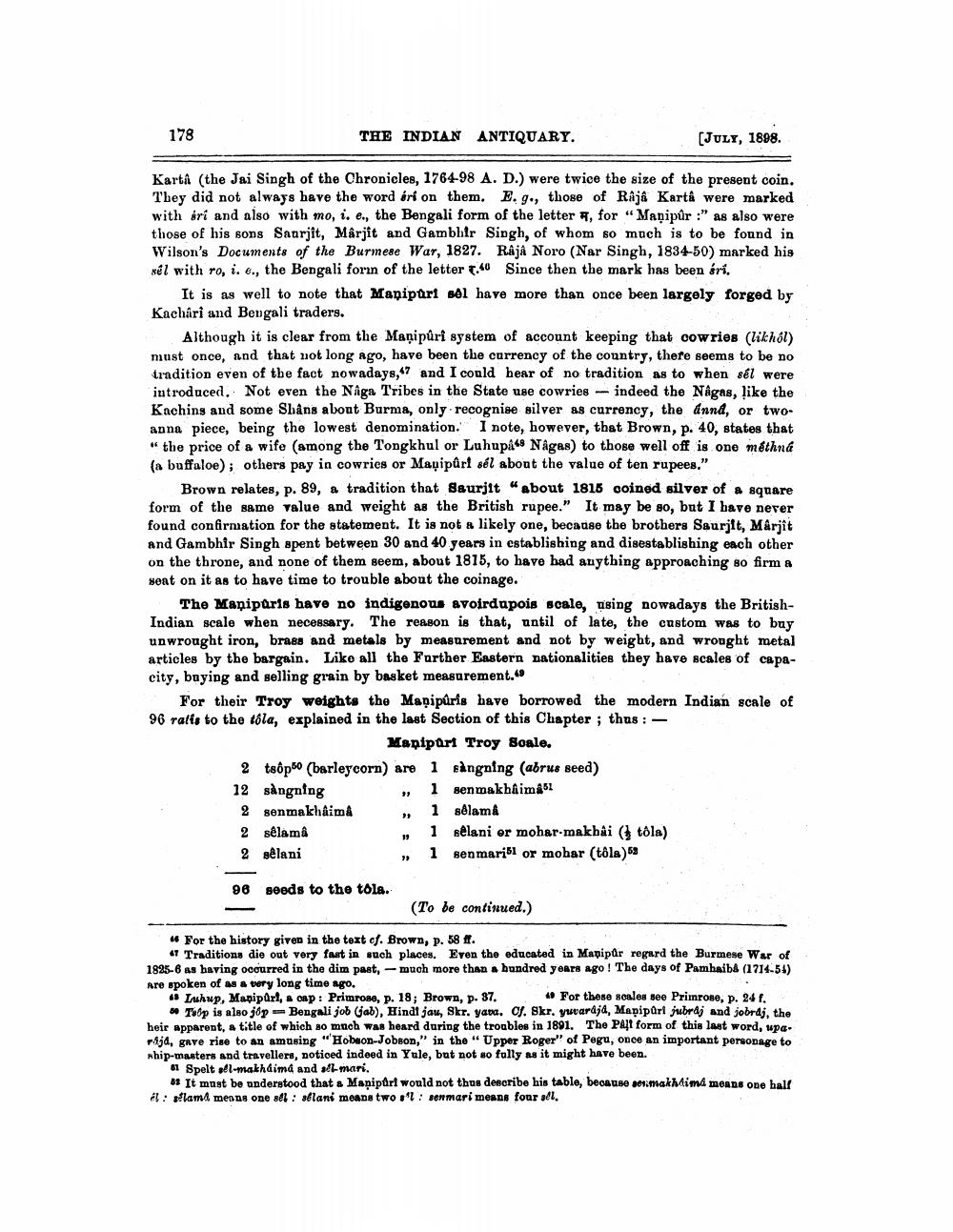________________
178
THE INDIAN ANTIQUARY.
(JULY, 1898.
Karta (the Jai Singh of the Chronicles, 1764-98 A. D.) were twice the size of the present coin. They did not always have the word óri on them. E.g., those of Raja Karta were marked with ári and also with mo, i. e., the Bengali form of the letter , for "Manipur :" as also were those of his sons Saarjit, Mârjit and Gambhir Singh, of whom so much is to be found in Wilson's Documents of the Burmese War, 1827. Raja Noro (Nar Singh, 1834-50) marked his nel with ro, i. 6., the Bengali forn of the letter T. Since then the mark has been éri.
It is as well to note that Manipuri sól have more than once been largely forged by Kachári and Bengali traders.
Although it is clear from the Manipürt system of account keeping that cowries (likhól) must once, and that not long ago, have been the currency of the country, there seems to be no tradition even of the fact nowadays, and I could hear of no tradition as to when sel were introduced. Not even the Naga Tribes in the State use cowries - indeed the Nágas, like the Kachins and some Shâns about Burma, only recognise silver as currency, the annd, or twoanna piece, being the lowest denomination. I note, however, that Brown, p. 40, states that
the price of a wife (among the Tongkhul or Luhupå Någas) to those well off is one méthna (a buffaloe); others pay in cowries or Mayipûri sél about the value of ten rupees."
Brown relates, p. 89, a tradition that Saurjit “about 1815 coined silver of a square form of the same value and weight as the British rupee." It may be so, but I have never found confirmation for the statement. It is not a likely one, becadse the brothers Saurjit, Márjit and Gambhir Singh spent between 30 and 40 years in establishing and disestablishing each other on the throne, and none of them seem, about 1815, to have had anything approaching so firm a sont on it as to have time to trouble about the coinage.
The Manipuris have no indigenous avoirdapois scale, using nowadays the BritishIndian scale when necessary. The reason is that, until of late, the custom was to buy unwrought iron, brass and metals by measurement and not by weight, and wrought metal articles by the bargain. Like all the Further Eastern nationalities they have scales of capacity, buying and selling grain by basket measurement.
For their Troy weights the Manipuris bave borrowed the modern Indian scale of 96 ralis to the tola, explained in the last Section of this Chapter ; thus:
Manipuri Troy Soale. 2 tsôp50 (barleycorn) are 1 sàngning (abrus seed) 12 sångning
1 senmakhaima52 2 senmakhâimâ
1 selama 2 selama
, 1 sllani or mohar-makbai (f tola) 2 sêlani
„ 1 senmari51 or mohar (tôla)
96
seeds to the tola.
(To be continued.)
4 For the history given in the text of. Brown, p. 58 ff.
47 Traditions die out very fast in such places. Even the educated in Mapipur regard the Burmese War of 1825-6 as having occurred in the dim past, - much more than a hundred years ago ! The days of Pamhaibd (1714-54) Are spoken of as a very long time ago. 15 Luhup, Mapipart, a onp: Primrose, P. 18; Brown, p. 37.
For these scales see Primrose, p. 24 f. Taop is also jo p = Bengali job (jab), Hindt jau, Skr. yada. Cf. Skr. yutardja, Manipuri jubraj and jobrdj, the heir apparent, a title of which so much was heard during the troubles in 1891. The Pall form of this last word, upa. mija, gave rise to an amusing "Hobson-Jobson," in the " Upper Roger" of Pegu, once an important personage to whip-masters and travellers, notioed indeed in Yale, but not so fully as it might have been.
61 Spelt sél-makhlima and silmari.
1 It must be understood that s Manipürt would not thus describe his table, because son makhlima means one hall a : silama means one sél : sélani means two o'l: senmari means four sl.




